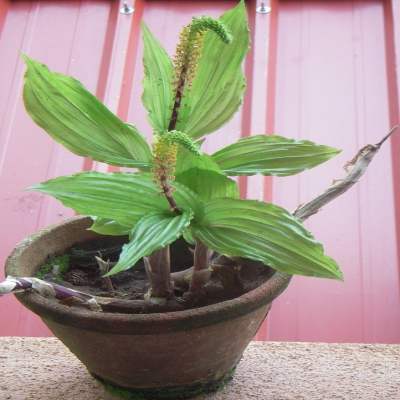Crepidium resupinatum (G. Forst.) Szlach.
Synonyms : Microstylis wallichii Lindl. , Malaxis rheedii (Sw.) , Microstylis versicolor Lindl , Malaxis versicolor (Lindl) , Malaxis acuminata D.Don. , Seidenfia rheedei (Sw.) Szlach.
Family : Orchidaceae
Vernacular Names :-
| English | : | Jeevak |
| Malayalam | : | Jeevakam |
| Hindi | : | Jivak |
| Sanskrit | : | Jivakah |
| Tamil | : | Jivakam |
| Telungu | : | Jivakamu |
Distribution and habitat: Throughout India, growing in shady places on clay, in sub mondanate or mid level tropical mid evergreen forest, extending to sub tropical mountain forest. It is a lithophytic orchid found on wet rocks, amidst moss and grass, in the opening of semi-evergreen and evergreen forests at altitudes ranging from 800-1100 m above MSL. The natural habitat is dripping rock ecosystem.
Botany: A short stemmed terrestrial herb up to 30 cm in height with more or less pseudo bulb at the base and fibrous roots. New plants arise from the side of the mother plant which is decaying.
- Leaves : Simple, three or four, alternate, sheathing, ovate or lanceolate.
- Flowers : Inflorescence is a long raceme with light brown rachis bearing numerous tiny flowers. Flower buds are green in colour, yellow when ripe. Peak flowering is during September. The two drugs jeevakom and edavakom in Kerala are pseudo-bulbils of the same plant but different only in size.
Chemical constituents:
- Jeevakam contains amino sugars, glycosides and hexosamine.
- Higher values of starch, free amino acids and protein were recorded in the domesticated crop.
Uses:
- The stem base is a refrigerant, aphrodisiac, febrifuge and tonic useful in seminal weakness, burning sensations, emaciation, tuberculosis and general debility.
- Jeevakom is used for treatment of haematemesis and fever.
Formulations: Dhanwantharam kashayam, Dhanwantharam kuzhambu, Asthavargam kashayam
Agrotechnology
Propagation: By side bulbils which sprout from mother bulbils.
Planting and aftercare: Bulbils are planted in May. Horizontal sowing under 50% shade was found better. By the end of January- February , Leaf sheath of the pseudobulb dries up and the bulbils go to dormant phase.
Harvesting: Bulbils harvested during February ie.after seven months of planting. For seed purpose, it can be stored inside earthen pots.

